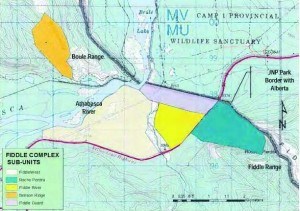
After months of speculation Parks Canada finally released its mountain pine beetle management plan for Jasper National Park, Aug. 15.
The 23-page plan includes several strategies to slow the eastward spread of the beetle, including using prescribed burns, cutting down individual/multiple trees and using harvesting equipment to eliminate larger patches of infected forest.
The publication of the official policy comes nearly five months after Parks Canada released a draft strategy of its plan, which indicated the beetle colonized approximately 21,500 hectares of forest in Jasper National Park in 2015, more than three times the amount than in 2014.
“Mountain Pine Beetle is viewed as a naturally occurring species within Jasper National Park, however, because of concerns about visitor and resident safety, potential increased risk of wildfire post outbreak and impact to neighbouring lands, Parks Canada policy allows for intervention,” wrote Steve Young, a communications officer for Jasper.
Prescribed burns major component of plan
According to the official plan, Parks intends to carry out a series of prescribed fires immediately west of town on the bench. The prescribed fires (six in total) will eliminate dead trees located upwind from town, thereby reducing the fire hazard.
Some control line work has already been completed or is currently under way in preparation for the prescribed burns, which could begin this fall.
Once the prescribed fires are complete Parks estimates it will eliminate 420 hectares of mountain pine beetle habitat upwind from town.
Parks also intends to carry out a series of prescribed fires in the Athabasca Valley near the Park’s eastern boundary to slow the spread of the beetle into neighbouring lands.
The Fiddle Complex is a series of five sub-units designed to remove susceptible pine trees at a pinch point in the valley between Boule and the Fiddle Ranges.

According to the management plan, some units could be burned as early as the fall.
Once all five units are burned, Parks estimates it will eliminate another 660 hectares of susceptible pine habitat.
How do mountain pine beetles kill trees?
The mountain pine beetle kills pine trees by burrowing under the bark and mining the phloem, the layer between the bark and wood of the tree. The beetles then lay eggs under the bark. After the eggs hatch, the grub-like larvae spend the winter feeding under the bark. The larvae pupate in the spring and usually emerge as adults from June 15 to July 1 before moving onto the next mature pine tree.
In addition to the damage caused by the beetle, which has a one-year life cycle, the species transmits a blue stain fungus during colonization. The combination of beetle tunneling and blue stain fungi disrupts the movement of water within the tree rapidly killing it and turning it red and dead.
Selective cutting targets beetle habitat
To slow the spread of the beetle Parks Canada also intends to cut down individual trees or small patches of infected trees on the eastern edge of the park where prescribed burns would not be feasible.
These areas include the Moose Horn Valley, the Fiddle Valley, southern sections of the Snake Indian Valley and the Athabasca Valley (within 15 km of the eastern boundary.)
After identifying infected trees and cutting them down, the trees will either be burned or grinded up to destroy the beetle broods.
One of the biggest challenges to implement this plan is accessibility. Road access is not available, however some areas will be accessible using snow machines and 4x4 quads. According to the plan, helicopters and the construction of remote helipads will likely be needed for more remote areas and higher elevations.
Parks will evaluate the feasibility and effectiveness of this plan on an ongoing basis.
In other areas of the park, Parks Canada intends to use harvesting equipment to remove infested trees in areas considered too large to tackle.
Machines will only be used in locations that are accessible, that create tangible benefits for the townsite and are ecologically based.
For example, harvesting equipment will likely be used to create fireguards ahead of the prescribed fires. According to Parks, establishing fireguards with harvesting equipment will decrease the complexity of the fires, which in turn will lower the cost and expedite the process.
Harvesting equipment will also be used to widen the Minaga, Tekarra Marsh and Cabin Lake/Stone Mountain strategic control lines, which were established in 2011.
Currently, these strategic control lines are narrow linear gaps in the forest that are about three or five meters wide. If they were widened to 30 to 50 metres they would provide better wildfire protection for the municipality and provide better access to other mountain pine beetle sites, according to Parks Canada.
What is Parks doing in town?
Parks Canada is also working with the municipality to identify and remove infected trees within the townsite and implement a verbenone program to stop beetles from colonizing healthy trees.
In the spring, Jasper’s environmental stewardship coordinator began giving away free verbenone pouches to residents to attach to their trees.
Verbenone is a pheromone naturally produced by adult beetles to let other beetles know a tree has already been colonized. The idea is that if people attach a pouch of artificial verbenone to a tree it will tell other beetles to stay away, thereby protecting it.
On top of this Parks will continue to implement its FireSmart program in and around the community to reduce the threat of wildfire and the amount of susceptible pine trees. Parks also intends to engage the public and teach people about the mountain pine beetle and its efforts to slow its spread and maintain the ecological integrity of the park.
Parks Canada is also working with the provincial government and the Canadian Forest Service to implement the overall plan.
To read the entire plan visit Jasper National Park’s website and click on park management on the sidebar.
Paul Clarke
[email protected]
